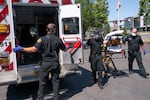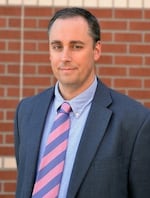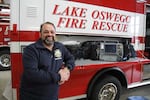
Salem Fire Department paramedics and employees of Falck Northwest ambulances respond to a heat exposure call during a heat wave, Saturday, June 26, 2021, in Salem, Ore.
Nathan Howard / AP
The toll from a heat wave that shattered temperature records across Oregon now stands at 116 people whose deaths were likely to due to heat-related causes, with more being discovered and reported by county medical examiners each day.
The 72-hour span between Saturday, June 26, and Monday, June 28 — when temperatures hovered above 110 degrees in many parts of the state — was the second-worst mass casualty event in Oregon’s history. The heat wave triggered a record number of 911 calls in the Portland metro area and overwhelmed hospitals already struggling with staffing shortages and pandemic burnout.
State and local officials have directed agencies to compile after-action reports, but those could take months to put together. With parts of the state already in the path of another heat wave, and two months of summer still on the horizon, many are feeling as if new strategies to protect Oregon’s most vulnerable can’t wait.
In the meantime, OPB reached out to six experts on first response, disaster planning and communications for their reflections on the extreme weather crisis Oregon is facing and how the state can better prepare.
A disaster expert makes the case for welfare checks
Randy Lauer is vice president of operations with American Medical Response Northwest.
Lauer has 40 years of experience in emergency medicine and 32 years of service with the U.S. Coast Guard. He was handing out bottled water and helping manage AMR’s teams of paramedics as they responded to a record number of 911 calls during the heatwave.
Lauer said Oregon has catching up to do, and he believes the public health emergency triggered by the heat caught the state by surprise.
“Surprise, not that it was going to get hot — that turned out like predicted. Surprised that we didn’t have more robust ways to identify who’s going to need the help the most,” Lauer said.
He believes that cooling centers are not, by themselves, an adequate strategy for saving lives, because the people who most need to cool down may not realize it - or may not be capable of calling 911.
“That’s one of the insidious things about heat issues,” Lauer said. “The deeper you get into the symptoms, the less wherewithal you have and ability you have to make good decisions and call for help.”
Lauer thinks Oregon could learn from best practices developed in the Southeast, where first responders have protocols for finding and evacuating vulnerable people before hurricanes. He thinks Oregon needs a catalogue of addresses of where homebound and other vulnerable people are, so that first responders can proactively do welfare checks during the next heat emergency.
“We need to figure out where people are and send out everybody we can to just check on them,” he said.
A paramedic and a social worker call for reimagining the approach to cooling centers
Paramedic Tremaine Clayton and social worker Britt Urban sometimes respond to 911 calls in the Lents neighborhood that involve homelessness or behavioral health, as part of the Portland Street Response pilot program.
It’s a neighborhood that suffers from the urban heat island effect — and saw a significant number of deaths during the heat wave. It’s hard to know exactly who died where, because state and county officials have not released information with that level of detail.
The street response team spent Portland’s hottest day on record hunting for ice and supporting community organizers who had set up a cooling station in Lents Park for people camping nearby.
They learned a multitude of lessons, but a few stand out.
First, if you’re going to distribute water bottles on a 116 degree day, freeze them first.
“By the midday, the water we had in our car was hot. Nobody wants to drink hot water,” Urban said.
Second, the city and county should think more flexibly about what places can serve as cooling centers during a heat wave.
On paper, the Holgate Library was the closest cooling center to most Lents residents.
But people who were homeless were afraid to leave their belongings behind, or to leave their pets suffering in the heat, to take shelter in the library.
“Within the houseless community, a lot of folks just don’t want to leave their community to go someplace else,” Clayton said.
Instead, other spaces in Lents turned into de-facto cooling shelters. Clayton said he brought one person sickened by the heat into a nearby air conditioned business.
“We didn’t really ask, we just went inside with the need of cooling,” he said. “And they were very accepting.”
Clayton thinks the city could do more outreach to businesses to find out which ones are willing to serve as refuges from the heat.
Thanks to community groups, and to houseless people who organized among themselves, Lents Park also became a cooling center of sorts.
Urban said she was able — eventually — to get a staff person from Portland Parks & Recreation to help set up a misting station there, but more planning and coordination with the parks bureau before the heat wave struck would have been helpful.
“If we had those conversations prior to the day of, it would have made more sense,” she said.
An ER doctor who is fired up about climate change
Oregon Health & Science University assistant professor of emergency medicine Dr. Bory Kea was working in the emergency department on Sunday, June 27 — in the middle of the heat wave.
According to Kea, the department became overwhelmed as it dealt with three simultaneous crises: people with heat exhaustion, a surprising surge in the number of trauma patients, and the ongoing COVID-19 pandemic.
Kea was surprised by the spike in trauma patients, and suspects heat may have been a factor in some of the incidents of trauma that brought people into her ER: drunken boating accidents and gun violence, among other examples.
“There have been studies that show that with increasing amounts of heat, people are also more irritable, and tend to be more aggressive and prone to violence,” she said.
Kea has ideas about steps Oregon can take to prepare for the next heat wave: adopting regulations to protect workers against having to labor outside in the 110 degree heat, for example. Oregon OSHA took steps in that direction earlier this week, by enacting temporary rules to protect workers in hot weather.
But Kea’s big idea is this: Treat the underlying problem, which is climate change.
Physicians need to start talking more with their patients and the public about how the changing climate will affect their health.
“We need to start talking about how can we improve our behavior, our actions, so that we can prevent this from worsening,” she said.
Oregon may not return to the mild summer days Kea remembers from her childhood in Salem, when not having air conditioning was a badge of honor. But she said limiting the number of extremely hot days is essential to protecting our health.
Oregon’s head disaster manager acknowledges the need for better communication

Andrew Phelps has been the director of Oregon's Office of Emergency Management since 2015.
Courtesy of the Oregon Office of Emergency Management
Andrew Phelps, director of Oregon’s Office of Emergency Management, said he’s “more than concerned” that future heat waves could coincide with deadly wildfires, putting further stress on the state’s emergency infrastructure and testing its response in ways it never has before.
Phelps said he believes the state and its residents need to fundamentally change how they view extreme weather events. Phelps said that currently, Oregon sees these as events as anomalies, when in reality they’re becoming commonplace.
“These are indicators of what types of events we need to be expecting and be prepared for as Oregonians, and that needs to drive how we’re planning,” Phelps said.
Phelps said he believes the state needs to rethink its approach to messaging, to reach its most vulnerable populations.
While social media and other technological forms of communication have made it easy for emergency managers to connect people in real time, that doesn’t work as effectively when the people who need to hear the message most don’t have access to the internet or a television.
He said that will be one of the biggest outcomes in assessing the state’s after-action report, as well as those submitted by each affected county in figuring out which demographics were most severely impacted by the heat.
Phelps said the Office of Emergency Management is also emphasizing individual preparedness and fostering the idea that Oregonians need to be checking on their neighbors to prevent people from slipping through the cracks when life and death are on the line.
“First responders can’t get to everyone, whether that’s a Cascadia earthquake or extreme heat,” he said.
Clackamas County’s EMS medical director knows that the state and region can do better
Dr. Ritu Sahni is an emergency physician at Providence Medical who also serves as emergency medical services director for Clackamas County and other local fire agencies.
According to Sahni, the 72 hours between Saturday, June 26, and Monday, June 28, were worse in terms of 911 calls and emergency room visits than any one point throughout the entire pandemic.

Aside from his job as an ER physician at Providence Medical, Dr. Ritu Sahni also serves as EMS medical director for Clackamas County and other local fire agencies.
Courtesy Photo
“When you look at the loss of life that we had ... it would be really hard to say that we did well. As public health professionals, these are not the outcomes that we wanted,” Sahni said. " I don’t think anybody’s happy with the amount of suffering that is occurring.”
Despite working nonstop for the past 18 months and short staffing in just about every hospital throughout the region, Sahni said, he believes emergency medical services workers responded heroically, but that’s not enough when the hospital systems statewide are stretched too thin as it is.
He said the experiences of EMS workers will be folded into the after-action reports by local government and state agencies and will hopefully provide a picture of what the state intends to avoid in future extreme weather events.
“In some respects, by the time EMS is involved, we’ve missed an opportunity,” Sahni said. “A lot of the future planning and focus has to be: ‘How do we prevent patients — or how do we prevent people — from getting to the point where they need emergency medical care?’”
A social services communications expert calls for low-tech solutions
Juliana Lukasik is public affairs and communications director with Central City Concern, a Portland-based nonprofit focused on helping people out of homelessness. With more than two decades of experience in the film and communications industries, Lukasik understands what it takes to get messages to stick.
She said it takes someone hearing a message at least three times in three different mediums for it to sink in, but one way to bypass that is using a method as old as time itself: word of mouth.
“The most effective way to communicate with a person is face to face. During an emergency, how do we reach people who are the hardest to reach? Outreach,” Lukasik said.
Lukasik commended state and local officials for their agility in setting up cooling centers. As a senior-level employee of one of the region’s largest service providers to unhoused community members, she didn’t hear of anyone who was in need being turned away.
What she questions is how the message was distributed, and wonders if the state — and the media — did all it could to ensure the information was reaching those who needed to know about available resources.
Some questions that remain swirling in Lukasik’s head include: Did our elected leaders have an in-person outreach strategy in place? Did they activate the community to check on their neighbors and be part of the emergency response? Did they work closely with the medical community to be ready for the massive increase in emergencies related to the heat?
“Our emergency communication strategy needs to be evaluated and made ready for the next emergency. Media has a role to play as well. I heard a lot from different media organizations asking electeds if they were prepared,” she said. “Did media outlets do enough to reach people beyond their own usual channels? We need to take a serious look at how we communicate and how we reach people who are harder to reach.”